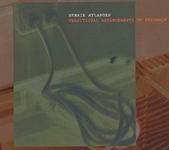|
|
 |
Dusted Reviews
Artist: Henrik Rylander Album: Traditional Arrangements of Feedback Label: iDEAL Review date: Jun. 1, 2004 |

|
|
|
 |
Feedback, once the unintentional and annoying result of a misplaced microphone or a problem with amplifier volume, has managed to escape its original classification as an unwanted and displeasing sound. To the general populous and the majority of live sound applications, of course, it’s still a problem to be dealt with – an aural pest – and numerous dictionary definitions of the word unabashedly call it an annoying or unpleasant sound. In rock music, however, feedback has found a place in the arsenal of even the only slightly creative or adventurous musician. The Velvet Underground and Jimi Hendrix were some of the first rock acts to utilize the sound, and attempted to both bend it to their will and ride it like a wild wave. Decades later, however, after Lou Reed’s Metal Machine Music, punk rock, Sonic Youth, and the emergence of a noise underground, it’s not surprising to see even some of the most contrived and polished alternative rock acts slip some feedback into the beginning of a song or place their guitars against their amps at the end of their set to set off a series of screeches and howls. Feedback has become a weapon of the rebellious, or an easy out for those who need to add an edge. This isn’t to say, though, that the development of feedback-infused music has reached a standstill. Plenty of contemporary acts, rock and otherwise, are still finding new and stimulating ways in which to make use of this formerly unwanted visitor.
Henrik Rylander, a Swedish artist once part of Union Carbide Productions, is a modern day feedback artist. In fact, this disc, his most recent, consists of feedback as its sole sound source, something the title of the disc, Traditional Arrangements of Feedback, might make it easy to deduce. As is also intimated by the disc’s title, Rylander’s use of feedback takes a more restrained approach, as he captures the sound, and, with the use of effects and filters, turns it into a controlled instrument all its own. Heavily rhythmic, the music rides a consistent beat throughout the duration of each track, as new sounds emerge in and around the pulse of the music. And though each track follows this basic pattern, Rylander’s music finds a way to be diverse in cadence and in tonal character, sometimes with cold glitches, and other times with ferocious clangs. The familiar peals of what could be termed “traditional” feedback are in very little evidence here, usually found only at a track’s conclusion, when Rylander strips away his constraints to allow the sound a fleeting moment of freedom before it decays and disappears.
Rylander has an impressive pedigree as an exhibiting electronic artist in Sweden, though, to the uninformed, some of his gritty rhythms might seem just as easily a product of America’s burgeoning noise underground. These slowing evolving/devolving minimalist pieces are provocative in both an intellectual and visceral sense, and it’s not a far stretch to liken this work to either the futurism of European IDM or the primitive sounds of the synthesizers of Suicide. These heavy, hypnotic recordings are relentless and riveting, deft works of rhythmic propulsion.
By Adam Strohm
|







